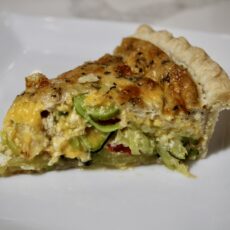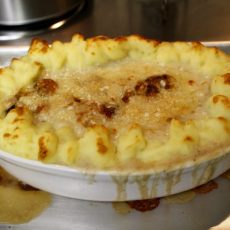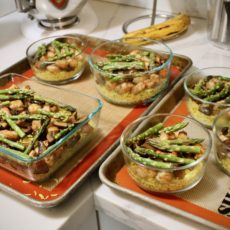I’m still on my quest to finish off the Fish/Seafood chapter, so expect some more fish entries in the near (maybe-not-so-near) future. 11-13: Flounder with Sautéed Vegetables sounds pretty…plain, but maybe that’s not a bad thing when it comes to whipping up an easy-ish dinner these days.

This card looks like it got slightly impacted during the “Great Roach Massacre of ’09“, but the important part (the recipe) is still plenty legible. All you’re missing here is Simply Delicious acting as 1980s hype man for including fish as part of your diet.

The TIPS sections offers the suggestion of different vegetables (if mushrooms, onion, and canned tomatoes don’t do it for you), but I’d also like to offer the idea of using different fish if needed (or desired).
My local market doesn’t often carry flounder, but they usually will have sole or halibut which are other similar types of flatfish that you can substitute. In fact, most sole sold in the U.S. is actually flounder, so even if you think you’re making a substitution, you might not be.

Ingredients. I’ve chosen to use some wild Petrale sole fillets I got from the local market for this recipe, since as I mentioned above, it can be difficult to find fresh “flounder” fillets. There’s some variation on the sustainability ratings of different types of flounder/sole–you can read more about that here. Flounder and sole have both made (and dropped off of) the “overfished” list in recent decades.
My breadcrumbs aren’t particularly fresh (as suggested), but will suffice for this recipe.

Prepping the fillets for coating. I like a three-step breading process that includes the dredging step (coating in flour), which they have omitted here, probably due to calorie concerns. It’s tough to get that coating to stick if you don’t use flour first. They don’t even have you use anything to stick the breadcrumbs to the fish–the milk you see here was an addition on my part.

Dipping the fish fillets into some oat milk I had, just to get the coating to stick somewhat. I would have used eggs if I had any, but the oat milk was aIl I had. If I had added the dredging step as well (coating in flour, then dipping in milk), it would have worked even better.

Coating the dipped fillets in the breadcrumbs. 8×8 cake pans seem to work well for this process.

After coating all the fillets. They look good now, but it’s going to be tough to get that coating to stay on there once they hit the pan.

I cheated and used diced tomatoes instead of whole ones. Why should I do the work if I can just get them already ready to go?
(I know the answer is “because doing it yourself usually results in a better product,” but if we’re already using canned tomatoes, I’m taking the easy way out too.)

Chopping up the onion.

And a blurry picture of slicing up the mushrooms.

Another blurry picture of the pan heating up.

Veggies sautéing in the pan.

Added in the tomatoes & oregano.

Looks a lot like the topping/sauce/veggies from 7-9: Hunter’s Style Pork Chops.

I pulled out the veggies and used the same pan for the fish fillets.

I could probably let it get browner, but I don’t want to overcook the fish.

After all 4 had pan-fried. They’re cooked, but it wasn’t pretty for some of them.

I selected my best contender and dressed it up with the veggie mix. With some rice or potatoes, it’s not a bad weeknight dinner option.
Grade: B+



